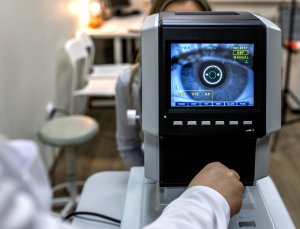Retinal Detachment Surgery in Palmyra, PA

Voted Best of Berks—
eight years in a row!
Retinal detachment is a serious condition when the retina, the light-sensitive layer at the back of the eye, separates from the underlying tissue. This prevents the retina from functioning properly, leading to vision loss and, if not treated promptly, blindness. At Eye Consultants of Pennsylvania, our experienced ophthalmologists offer advanced retinal detachment surgery to restore vision and prevent further complications for Palmyra, PA, and the surrounding community.
Causes and Symptoms of Retinal Detachment
Retinal detachment can happen for various reasons. A few common causes include:
- Aging: As we age, the vitreous gel inside the eye shrinks and can pull away from the retina, creating tears or holes that may lead to detachment.
- Eye Injury: Trauma to the eye can damage the retina and cause it to detach.
- Previous Eye Surgery: Surgeries such as cataract removal can increase the risk of retinal detachment.
- High Myopia (Nearsightedness): People with severe myopia have longer eyeballs, making the retina more susceptible to detachment.
- Family History: Genetics can also play a role in increasing the risk of retinal detachment.
Early detection is crucial in treating retinal detachment effectively. Common symptoms include:
- Sudden Appearance of Floaters: These are small specks or threads that drift across your field of vision.
- Flashes of Light: Experiencing flashes, especially in the peripheral vision, can indicate retinal issues.
- Shadow or Curtain Over Vision: A shadow or dark curtain moving across your visual field is a sign that immediate medical attention is needed.
If you experience these symptoms, please seek immediate medical care to prevent permanent vision loss.
Types of Retinal Detachment Surgery
The specialists at Eye Consultants of Pennsylvania use several surgical techniques to treat retinal detachment, depending on the severity and location of the detachment:
- Pneumatic Retinopexy: A gas bubble is injected into the eye to press the retina against the eye wall. The patient must keep their head in a specific position for several days to ensure the bubble stays in place, sealing the retinal tear.
- Scleral Buckling: A small, flexible band is placed around the sclera (white part of the eye) to gently push the wall of the eye against the detached retina. This procedure is effective for more extensive detachments and is often combined with other treatments.
- Vitrectomy: This procedure involves removing the vitreous gel from the eye and replacing it with a saline solution or gas bubble. It is commonly used for complex detachments, such as those caused by severe retinal tears or scar tissue formation.
Surgical Recovery and Aftercare
After retinal detachment surgery, recovery and post-operative care are essential for the best outcomes:
- Follow-up Appointments: Regular check-ups ensure that the retina is healing properly and that no complications arise.
- Medication: Eye drops may be prescribed to prevent infection and reduce inflammation.
- Positioning: Depending on the type of surgery, you may need to maintain a specific head position for several days to keep the gas bubble in place.
- Activity Restrictions: To reduce pressure on the eye, avoid strenuous activities, heavy lifting, and bending over during the recovery period.
Vision improvement can take several weeks to months, and some patients may need additional treatments to achieve the best results.
Preserve Your Vision
At Eye Consultants of Pennsylvania, our team of skilled retinal specialists is dedicated to providing the highest standard of care and surgical treatment for retinal detachment near Palmyra, PA. We are here to help you prevent further complications and maintain your vision and independence with early intervention and exceptional care. Visit our Retinal Eye Care page for more information.
Find a Doctor
Physician information including education, training, practice location and more.
Schedule an Appointment
Call 800-762-7132 or make an appointment online.





